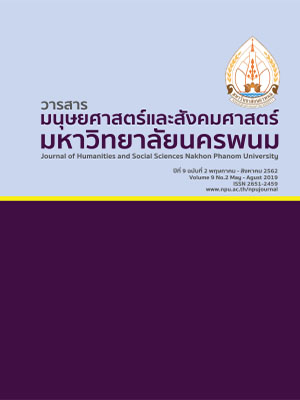The Causal of Factors Influening the Effectiveness of the Private Schools in Thailand
Main Article Content
Abstract
The purposes of this research were: 1) to examine the consistency of the model of factors influencing the effectiveness of private schools in Thailand, 2) to investigate direct, indirect and total effects of factors influencing the effectiveness of private schools in Thailand. The samples of study selected by multi-stage sampling were 420 school directors. The research instruments were a questionnaire with Cronbach’s alpha coefficients ranging from 0.89-0.96. Data were analyzed for frequency, percentage, mean, standard deviation, Skewness, Kurtosis, Pearson’s product moment correlation coefficient. the LISREL software was employed to analyze the causal relationship model
The research findings were summarized as follows: 1) The developed model showed a goodness-of-fit with the empirical data by gaining the following values: 2 = 114.65 df = 109 P-value = 0.337 GFI = 0.97 AGFI = 0.9 RMSEA = 0.011 SRMR = 0.018 and CN = 507.32. The R-square of the casual factors influencing the effectiveness of private school in Thailand was at 88 Percent (R2 = 0.88), 2) The factors influencing the effectiveness of private school in Thailand were as the following. The direct effect had five factors: school competency, instructional leadership, learning management, school atmosphere and community participation respectively. The indirect effects were instructional leadership, school atmosphere and school competency. The total effects were instructional leadership, school competency, learning management, school atmosphere and community participation respectively.
Article Details
References
มหาวิทยาลัยราชภัฏวไลยอลงกรณ์ในพระบรมราชูปถัมภ์. 8(1), 167.
ทิศนำ แขมมณี. (2545). ศาสตร์การสอน : องค์ควำมรู้เพื่อกำรจัดกระบวนกำรเรียนรู้ที่มีประสิทธิภำพ. กรุงเทพฯ : ส้ำนักพิมพ์แห่ง
จุฬำลงกรณ์มหำวิทยำลัย.
ธวัชชัย ตั งอุทัยเรือง. (2557). โมเดลควำมสัมพันธ์เชิงสำเหตุของประสิทธิผลโรงเรียนประถมศึกษำขนำดเล็กสังกัด
ส้ำนักงำนคณะกรรมกำรกำรศึกษำขั นพื นฐำนในภำคกลำงของประเทศไทย. วารสารบัณฑิตศึกษามหาวิทยาลัย
ราชภัฏวไลยอลงกรณ์ในพระบรมราชูปถัมภ์. 8(1), 105.
บุญชม ศรีสะอำด. (2554). การวิจัยเบื้องต้น. พิมพ์ครั งที่ 10. กรุงเทพฯ: สุวีริยำสำส์น.
พัทธโรจน์ กมลโรจน์สิริ. (2557). ปัจจัยที่ส่งผลต่อโรงเรียนเอกชนในประเทศไทย. วิทยำนิพนธ์ปริญญำศึกษำศำสตร
ดุษฎีบัณฑิต. กรุงเทพฯ : มหำวิทยำลัยเกษตรศำสตร์.
พูลพงศ์ สุขสว่ำง. (2556). โมเดลสมการโครงสร้าง. กรุงเทพฯ : วัฒนำพำณิชย์.
ยงยุทธ วงศ์ภิรมย์ศำนดิ์. (2557). สร้างสุขด้วยสติในองค์กร. กรุงเทพฯ: มหำวิทยำลัยมหิดล.
วรรณภำ สมตำ. (2560). ควำมสัมพันธโครงสรำงเชิงเสนของปจจัยที่สงผลตอประสิทธิผลของโรงเรียนมัธยมศึกษำในสังกัดองคกร
ปกครองสวนทองถิ่น. วารสารบริหารการศึกษา มหาวิทยาลัยขอนแกน. 13(1), 101.
สุนทร กุญชร. (2557). ปัจจัยเชิงสาเหตุที่ส่งผลต่อประสิทธิผลของโรงเรียนประถมศึกษาจังหวัดชัยภูมิ. วิทยำนิพนธ์ ปริญญำปรัชญำ
ดุษฎีบัณฑิต. กรุงเทพฯ : มหำวิทยำลัยรำชภัฏบ้ำนสมเด็จเจ้ำพระยำ.
สุวิมล ติรกำนันท์. (2553). การวิเคราะห์ตัวแปรพหุในงานวิจัยทางสังคมศาสตร์. พิมพ์ครั งที่ 1.กรุงเทพฯ. ส้ำนักพิมพ์
แห่งจุฬำลงกรณ์มหำวิทยำลัย.
โสภิณ ม่วงทอง. (2556). ปัจจัยที่ส่งผลต่อประสิทธิผลของโรงเรียนเอกชน ประเภทสำมัญในภำคตะวันออก.วารสารการบริหาร
การศึกษา มหาวิทยาลัยบูรพา. 7 (1), 25.
ส้ำนักงำนเลขำธิกำรสภำกำรศึกษำ. (2556). รายงานการพิจารณาศึกษา เรื่องนโยบาย ยุทธศาสตร์ สาหรับการพัฒนาและแก้ไข
ปัญหาการศึกษาเอกชนให้เข้มแข็ง. สืบค้นเมื่อ พฤศจิกำยน 2561, จำก
https://www.onec.go.th/index.php/book/BookView/378.
Dubrin, A. J. (1998). Leadership: research findings, practice, and skills: Queensland: John Wiley & sons.
Hoy, W. K., & Miskel, C. G. (2008). Educational administration: Theory, research and practice (8 th ed.).
Singapore: McGraw Hill.
Jackson, B. W., & Holvino, E. (1986). Working with multicultural organizations: Matching theory and practice.
New York, NY: Allyn and Bacon.
Zammuto, R.F. (1982). Assessing Organizational Effectiveness, System Channge, Adaptation and Strategy.
Albany: State University of New York Press.


